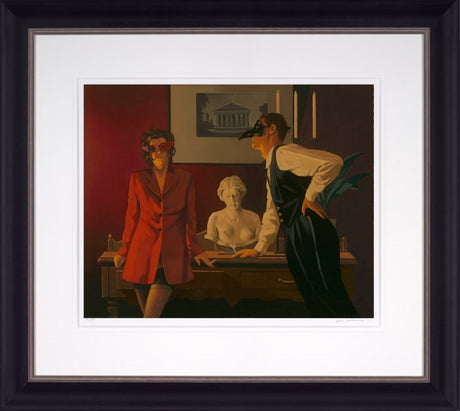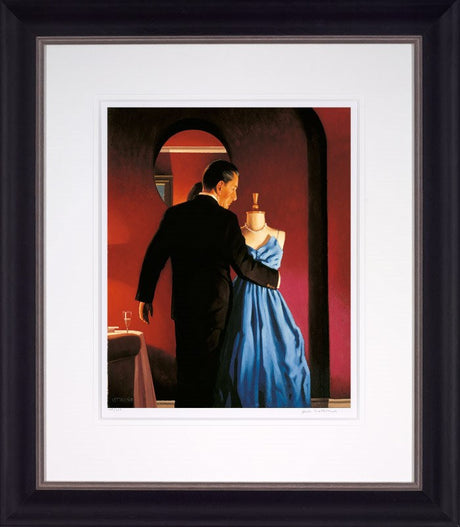Jack Vettriano
(3 products)Jack Vettriano is something of a late-comer to the whole professional art scene, having not made a name for himself until well into his 30s. And we mean, ‘well into’. That’s not to imply that the uber successful contemporary figurative artist was sat at home in front of The Jeremy Kyle Show and Homes Under The Hammer for the best part of twenty years previous to this, mind. On the contrary, as Vettriano pursued alternative careers during these initial chapters of his working life. Vettriano, it’s fair to say was born (1951) into a life of near poverty, where childhood memories were ones of living a pretty much hand to mouth existence. Growing up in the industrial seaside town of Methil, in Fife in Scotland, Vettriano lived with his mother and father and older brother, in a spartan miner’s cottage, sharing a bed with his brother and wearing hand-me-down clothes. At the tender age of 10, Vettriano’s father insisted that he should become a family bread-winner himself, and so packed him off to deliver papers and milk, cleaning windows, picking potatoes and any job that would earn money. It’s said that Vettriano’s father took half of his younger son’s earnings for the family coffers.
At the age of 16 Vettriano quit school and started an apprenticeship as a mining engineer nearby, while there’s also talk of him holding down a seasonal job as a bingo caller at the Beachcomber Amusement arcade on Leven Promenade in the late 1960s. Over a period of time Vettriano entered the educational research field, and only took up painting as an escape from the everyday; and in the aftermath of his then girlfriend purchasing him a set of watercolours for his 21st birthday which was marked in 1972 if our calculations are correct. Under the pseudonym, ‘Jack Hogan’, Vettriano’s first illustrative forays were into pastiches of famous impressionist paintings; with his very first visual rendition being his interpretation of Monet’s ‘Poppy Fields’. It’s said that a large degree of Vettriano’s inspiration was derived from countless visits to the Kirkcaldy Museum and Art Gallery, which he’d make regular pilgrimages to as his interest for art and certain movements and exponents developed.
From this point forward, Vettriano dedicated much of his spare time to teaching himself the rudiments of painting and evolving what he knew and understood, and in 1984 he was confident enough in his own work to hold his first piece up for public scrutiny, by way of submitting a composition into the Shell-sponsored art exhibition hosted by the aforementioned museum. This proved to be the start of Vettriano’s creative awakening and journey as such, as he rallied to craft more and more pieces as he attempted to hone both his skills and lay down a style with which he’d grow to be accustomed to and associated with. In 1987, and at the age of 36, Vettriano’s wife left him, which seems to have proved the catalyst for a few momentous life events which quickly followed. Leaving his role in educational research, Vettriano also moved to Edinburgh shortly after, where he chose to adopt his mother’s maiden name and saw him give away his suits to a neighbour; before electing to start dressing as, what spectators at the time considered to be, an Edwardian dandy. Vettriano also took it upon himself to enrol at the University of Edinburgh to study Fine Art, however had his portfolio rejected at the time.
Thankfully this set-back didn’t dent Vettriano’s belief in his artistic ability and in 1989 he submitted two paintings to the Royal Scottish Academy’s annual exhibition; both were accepted and sold on the first day. The following year, an equally enthusiastic reaction greeted the three paintings which Vettriano entered for the prestigious Summer Exhibition at London’s Royal Academy and his new life as an artist was suddenly starting to take shape. Over the past two decades Vettriano’s work has found a massive fanbase and grown in popularity with a reassuring consistency, which has also been supported by sell out solo exhibitions in not just Edinburgh and London, but at prestigious venues and galleries further afield in both New York and Hong Kong to date. Not that it’s been classed as plain sailing all that time, as it’s fair to say that Vettriano polarises artistic opinion.
Whilst Vettriano certainly revels in the plaudits of many contemporary art observers, movers and shakers - and has an army of loyal followers who hang on his every compositional release - there are some critics who’s savagery is barely masked. Take for example, The Daily Telegraph who famously described Vettriano as ‘the Jeffrey Archer of the art world’ and a ‘purveyor of badly conceived soft porn and dim erotica’. Which is more in keeping with a Daily Mail opinion, surely? And according to Vanity Fair, critics say Vettriano paints ‘brainless erotica’. Elsewhere and Sandy Moffat, head of drawing and painting at Glasgow School of Art, said: "He can’t paint, he just colours in”, while The Guardian's art critic Jonathan Jones, described Vettriano as “not even an artist”. Which is all a bit handbags it would appear. Despite this, other artists readily spring to Vettriano’s defence. Like sculptor, David Mach, who, regarding the criticism levelled against Vettriano has gone on record as saying; If he was a fashion designer Jack would be right up there. It’s all just art world snobbery. Anyway, who cares, he probably makes more money than Damien Hirst anyway”.
There is indeed something of the enigma about Vettriano to our mind, as a quick trawl of Wikipedia concurs. Especially the bit where, according to an interview with The Independent newspaper in 2010, Vettriano conceded; “I live in a world of heartbreak….I just seem to be more creative when I’m in some kind of emotional distress”. Add to this his claims of “25 years of sexual misbehaviour” as chief amongst his painting inspirations, a gambling habit and a penchant for nicotine, alcohol, anti-depressants and Temazepam and you build your own picture of an artist who’s lived his life on the edge to a certain degree.
But then all this is countered by Vettriano’s misanthropistic values and ideals. Not least the setting up of his Vettriano Trust – through which he plans to leave money for good causes after his death - and a scholarship scheme to fund students hoping to attend St Andrew’s University in Scotland. And then there’s Vettriano’s charitable donations, with monies raised through the sales of some of his signature works at special auctions. The Terence Higgins Trust, Help the Hospices, Sport Relief, The Elephant Family and a number of Scottish-based charitable organisations have all benefitted from proceeds directly from Vettriano’s art.
Looking back as to how far the self-taught Vettriano has come, albeit in a belated time frame too, and the ever-popular contemporary figurative artist is enjoying the fruits of his labour these days. 2004 stands out as being an exceptional year in Vettriano’s career; his best known painting, The Singing Butler’ was sold at Sotheby’s for close to £750,000, while in the same 12 months he was awarded an OBE for Services to the Visual Arts alongside of being the subject of a South Bank Show documentary, entitled ‘Jack Vettriano: The People’s Painter‘. In 2008, Vettriano undertook a variety of private projects, including the launch of a new book, ‘Studio Life’, and commissions to paint portraits of Sir Jackie Stewart and Zara Phillips, the latter of which was part of a charity fund-raising project for Sport Relief. Then, in 2009, Vettriano was commissioned by the Yacht Club of Monaco to create a series of paintings to mark the centenary of their world famous yacht, Tuiga. The subsequent exhibition, ‘Homage a Tuiga‘, premiered in Monaco as part of Classic Yacht Week in September 2009, before touring to the UK in 2010.
In 2010, an exhibition of in excess of 40 new paintings, ‘Days of Wine & Roses‘, was officially opened at the Kirkcaldy Museum & Art Gallery in Fife, by First Minister, the Rt Hon Alex Salmond SNP, which was followed in December 2011 by the revealing of Vettriano’s self-portrait, ‘The Weight‘, which subsequently went on long-term display at the Scottish National Portrait Gallery in Edinburgh. In 2013 a major Retrospective exhibition to mark 20 Years of Vettriano’s career opened at Kelvingrove Art Gallery & Museum, Glasgow, and runs until late February 2014.
Vettriano divides his time between his homes in Fife, London and Nice.
- Featured
- Best selling
- Alphabetically, A-Z
- Alphabetically, Z-A
- Price, low to high
- Price, high to low
- Date, old to new
- Date, new to old






